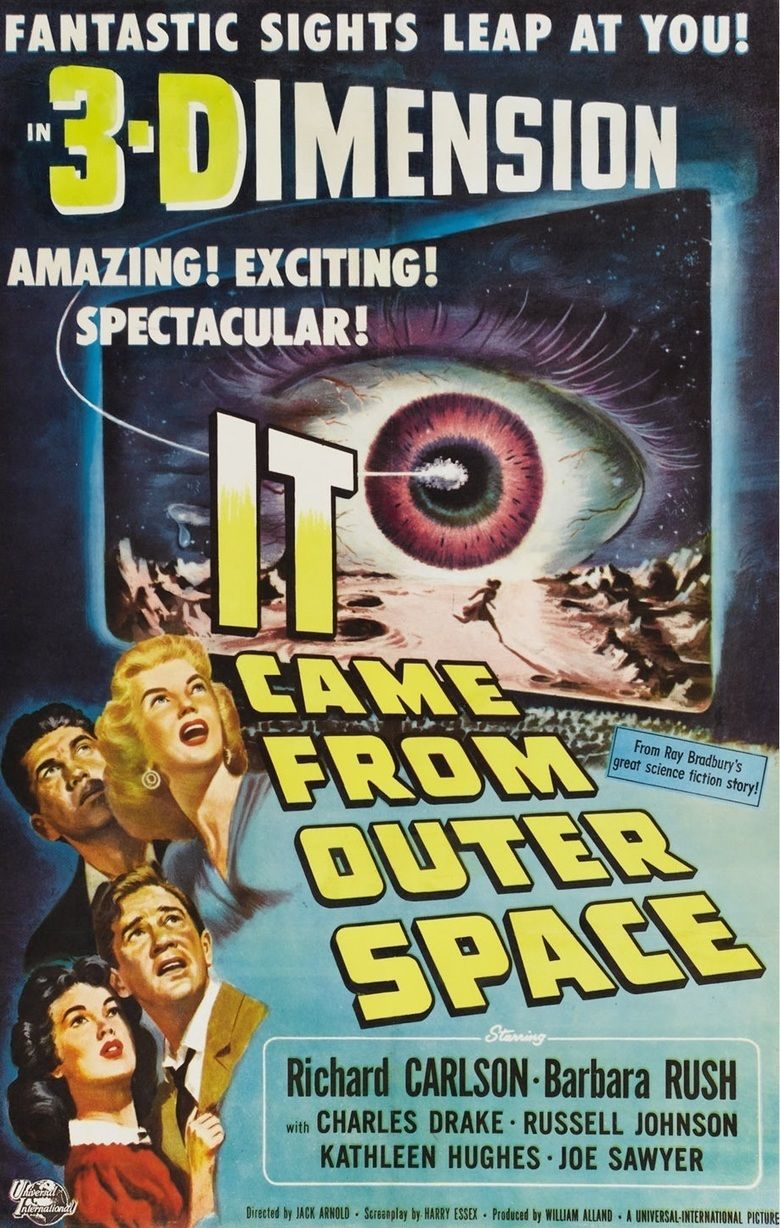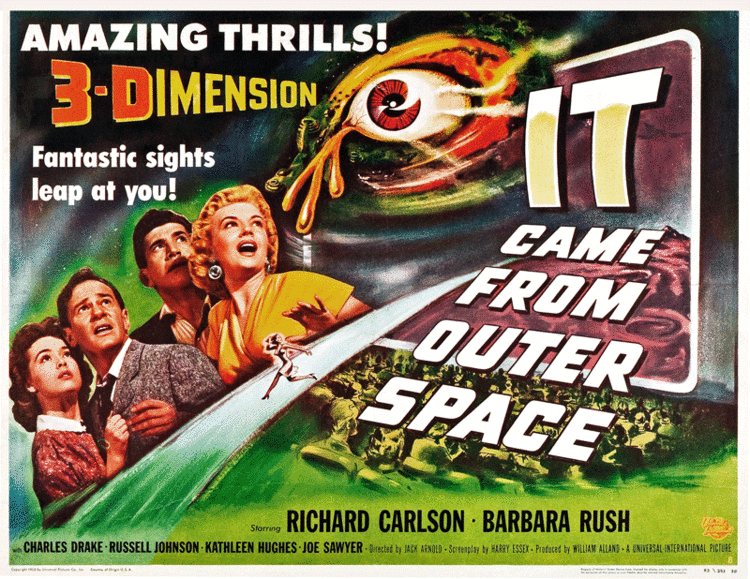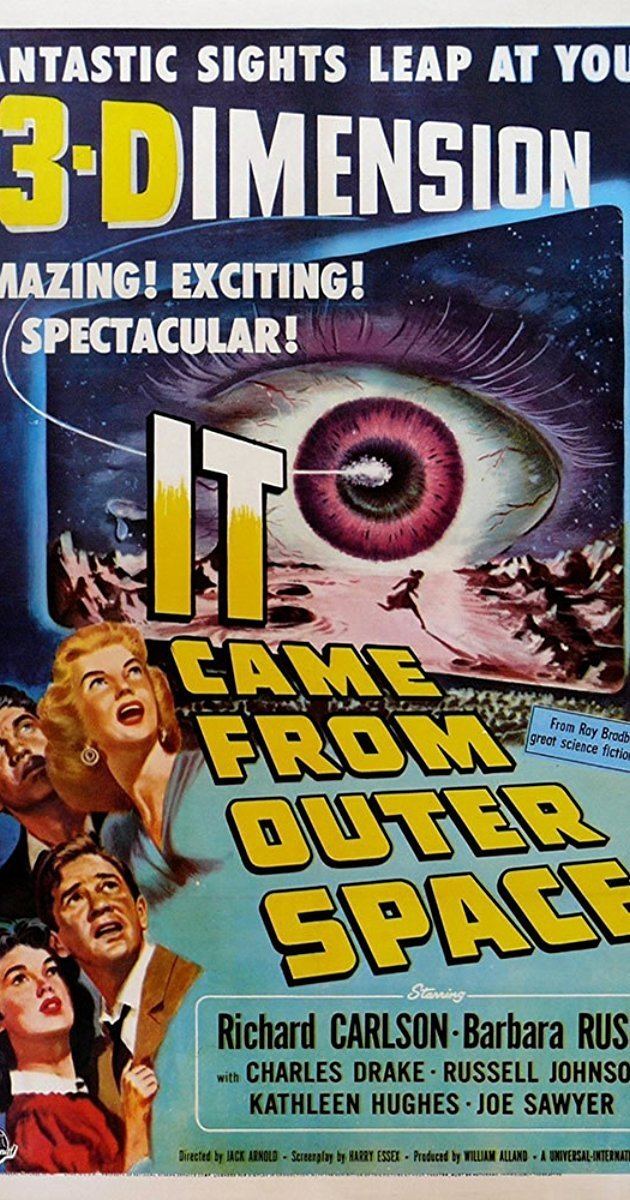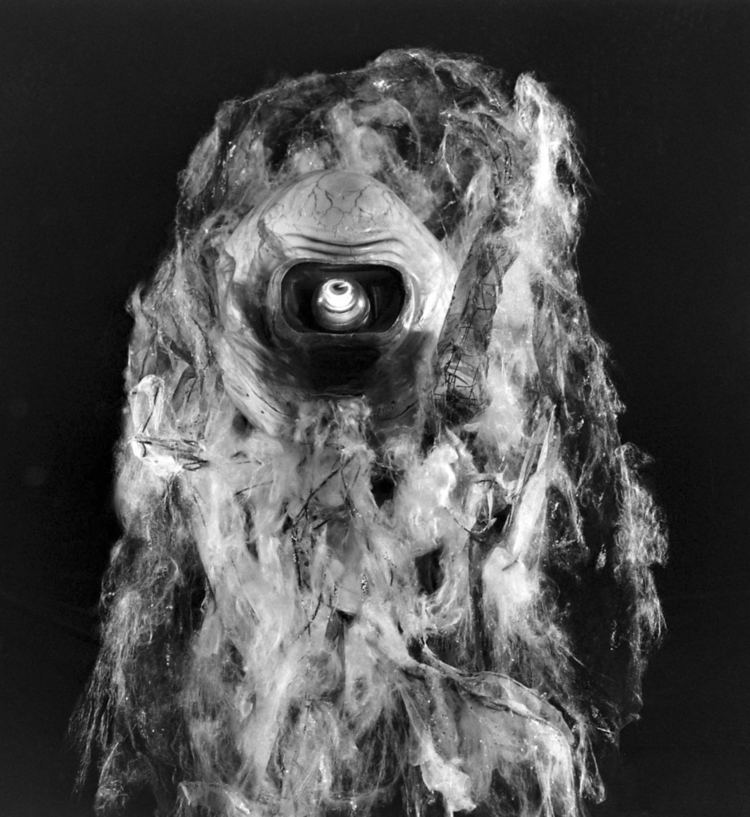It Came from Outer Space
7.4 /10 1 Votes
81% Rotten Tomatoes Genre Horror, Romance, Sci-Fi Film series Universal horror Country United States | 6.6/10 IMDb Initial DVD release May 21, 2002 Duration Language English | |||||||||||||||||||||||||||||||||
 | ||||||||||||||||||||||||||||||||||
Release date May 25, 1953 (1953-05-25) Cast (John Putnam), (Ellen Fields), (Sheriff Matt Warren), (Frank Daylon), (George), (Pete Davis) Similar movies Tremors , Independence Day , Tremors 3: Back to Perfection , Starship Troopers 2: Hero of the Federation , The Day the Earth Stood Still , Tremors II: Aftershocks Tagline Fantastic sights leap out at you! | ||||||||||||||||||||||||||||||||||
It came from outer space 1953 official trailer movie hd
It Came from Outer Space is a 1953 American black-and-white science fiction horror film, the first in the 3D process from Universal-International. It was produced by William Alland, directed by Jack Arnold, and stars Richard Carlson, Barbara Rush, and Charles Drake. The film's script is based on Ray Bradbury's original story treatment (not, as sometimes claimed, a published short story) "The Meteor".
Contents
- It came from outer space 1953 official trailer movie hd
- Plot
- Cast
- Production
- Reception
- Reviews
- Video releases
- References

It Came from Outer Space tells the story of an astronomer and his fiancee who are stargazing in the desert when a large fiery object crashes to Earth. At the crash site, he discovers a round alien spaceship just before it is completely buried by an overhead landslide. When he tells this story to the local sheriff and newspaper, he is branded a crackpot. Before long, strange things begin to happen, and the tide of disbelief turns hostile.

Plot

Author and amateur astronomer John Putnam (Richard Carlson) and schoolteacher Ellen Fields (Barbara Rush) watch a large meteorite crash near the small town of Sand Rock, Arizona. They awaken a neighbor, who has a helicopter, and all three fly to the crash site. Putnam climbs down into the crater and notices a partially buried round object in the crater's pit. He comes to the realization, after he sees a six-sided hatchway close, that this isn't a meteorite but a large alien spaceship. The hatchway's noise starts a landslide that completely buries the craft. Putnam's story is later scoffed at by Sand Rock's sheriff (Charles Drake) and the local news media.

Even Ellen Fields is unsure about what to believe but still agrees to assist Putnam in his investigation. Over the next several days, local people disappear; a few return, but they act distant or appear somewhat dazed and not their usual selves. Convinced by these and other odd events, Sheriff Warren comes to believe Putnam's story that the meteorite is actually a crashed spaceship with alien inhabitants; he then organizes a posse to hunt down the invaders at their crash site. Putnam, however, hopes to reach a peaceful solution to the looming crisis. Alone, he enters a nearby abandoned mine, which he hopes will eventually connect to the now buried spaceship and its alien occupants.

Putnam finally discovers the spaceship and learns from the alien leader that they crashed on Earth by accident; the aliens appear benign and only plan to stay on Earth just long enough to repair their damaged craft and then continue on their voyage. The aliens' real appearance, when finally revealed to Putnam, is entirely non-human: they are large, single-eyed, almost jellyfish-like beings that seem to glide across the ground, leaving a glistening trail that soon vanishes. They are also able to shape shift into human form in order to appear human and move around Sand Rock, unobserved, in order to collect their much needed repair materials. To do this, they copy the human forms of the local townspeople that they have abducted. In doing so, however, they fail to reproduce the townspeople's exact personalities, leading to suspicion and eventually to the deaths of two of the aliens.

To protect the aliens from the sheriff and his advancing posse, Putnam manages to seal off the mine in order to give them the time they still need to finish their spaceship's repairs. However, they have decided to destroy themselves and their spaceship, now that they have been discovered. Putnam reasons with them at length and convinces the alien leader to instead finish the repairs while he, as a sign of the aliens' good will, takes the captives outside to the sheriff. Not long thereafter, the alien spaceship leaves Earth, returning to the stars.
Cast

Production

The screenplay by Harry Essex, with input by Jack Arnold, was derived from an original and lengthy screen treatment by Ray Bradbury; screen legend says that Bradbury wrote the screenplay and Harry Essex merely changed the dialogue and took the credit. Unusual among science fiction films of the era, the alien "invaders" were portrayed by Bradbury as creatures stranded on Earth and without malicious intent toward humanity. The film can be interpreted as a metaphorical refutation of the supposedly xenophobic attitudes and ideology of the Cold War. Bradbury said "I wanted to treat the invaders as beings who were not dangerous, and that was very unusual". He offered two story outlines to the studio, one with malicious aliens, the other with benign aliens. "The studio picked the right concept, and I stayed on". In 2004 Bradbury published in one volume all four versions of his screen treatment for It Came From Outer Space.
Filming took place on location in and around the California towns of Palmdale, Victorville, and the Mojave Desert, as well as on Universal's sound stages.
The film's uncredited music score was composed by Irving Gertz, Henry Mancini, and Herman Stein.
Universal's make-up department submitted two alien designs for consideration by studio executives; the rejected design was saved and then later used as the "Metaluna Mutant" in Universal's 1955 science fiction film This Island Earth.
The special effects created for the in-flight alien spacecraft consisted of a wire-mounted iron ball, with hollowed out 'windows,' with burning magnesium inside.
The Arizona setting and the alien abduction of telephone lineman and two other characters are fictionalized story elements taken from Bradbury's younger life when his father moved the family to Tucson, where he worked as a telephone lineman.
Urban legend has it that an extra in an Army corporal's uniform seen at the "meteor" crash site is comedy writer-performer Morey Amsterdam. While the briefly glimpsed extra does indeed resemble Amsterdam, no hard evidence (e.g., cast call bureau records, interviews with Amsterdam) has ever confirmed this is actually him. The most recent DVD re-release of It Came from Outer Space comes with a documentary, "The Universe According to Universal." It was written and directed by David J. Skal and has audio commentary by Tom Weaver, in which Weaver notes the extra's similarity to Morey Amsterdam.
Reception
It Came from Outer Space was released in June 1953; by the end of the year it had accrued US$1.6 million in distributors' US and Canadian rentals, making it the year's 75th biggest earner.
Barbara Rush won the Golden Globe award in 1954 as most promising female newcomer for her role in the film.
The film was nominated for AFI's Top 10 Science Fiction Films list.
Patricia Bosworth, writing in 1992, counted It Came from Outer Space as one of a number of anti-Communist propaganda films in which "aliens from outer space serving as metaphors for the Soviet menace". Bosworth's inclusion of "It Came From Outer Space" as an example of Hollywood anti-Communist propaganda made during The Korean War is at odds with The American Film Institute and story author Ray Bradbury who stated, "I wanted to treat the invaders as beings who were not dangerous, and that was very unusual". Zero Earthlings are killed or injured in the movie by the invading aliens. If these aliens were intended to be stand-ins for the Soviet Union/Communists as Bosworth professes, their presence in an Arizona town is antithetical to how surrogates for Communists were portrayed in Hollywood Sci-Fi films during the Cold War. Bosworth blames her father Bartley Crum's 1959 death (which she calls a suicide) on his being targeted by the Hollywood Blacklist. Crum died of an alcohol and barbiturate overdose.
Reviews
The New York Times review by A. H. Weiler noted "the adventure ... is merely mildly diverting, not stupendous. The space ship and its improbable crew, which keep the citizens of Sand Rock, Ariz., befuddled and terrified, should have the same effect on customers who are passionately devoted to king-sized flying saucers and gremlins". "Brog" in Variety opined that "Direction by Jack Arnold whips up an air of suspense in putting the Harry Essex screenplay on film, and there is considerable atmosphere of reality created, which stands up well enough if the logic of it all is not examined too closely ... story proves to be good science-fiction for the legion of film fans who like scare entertainment, well done".
Since its original release, the critical response to the film has become mostly positive. Bill Warren has written that “Arnold’s vigorous direction and Bradbury’s intriguing ideas meld to produce a genuine classic in its limited field". Jonathan Rosenbaum described the film as "[A] scary black-and-white SF effort from 1953". Phil Hardy’s The Aurum Film Encyclopedia: Science Fiction observed "Dark desert roads and sudden moments of fear underline Arnold’s ability as a director of Science Fiction films, and Essex's/Bradbury's lines match his images superbly". Of the reviews included on Rotten Tomatoes regarding It Came from Outer Space, 81% of critics liked the film. In one of the negative reviews, FilmCritic.com opines that the film "moves terribly slowly (despite an 80 minute running time) because the plot is overly simplistic with absolutely no surprises".
Video releases
Universal digitally restored It Came From Outer Space and in October of 2016 released the film on Blu-ray. The film is presented in original widescreen polarized 3D, with three-track stereophonic sound. Also included is a non-3D "flat" version with mono sound. Both 3D and flat trailers are also included. Rounding out the Blu ray package is a documentary on Universal's 3D films and a "making of" voice-over commentary track.
References
It Came from Outer Space WikipediaIt Came from Outer Space IMDbIt Came from Outer Space Rotten TomatoesIt Came from Outer Space themoviedb.org
